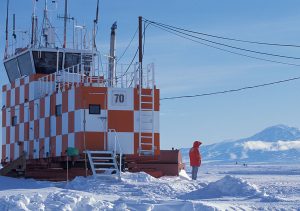Nestled at the southern tip of Ross Island, just off the Antarctic coast, lies one of the most remote towns in the world. McMurdo Station
(WAP USA-22) is the main U.S. outpost in Antarctica, built on an outcropping of rugged volcanic rock.

McMurdo Station has no permanent residents — just a revolving door of visiting scientists and temporary personnel, some of whom live there for up to a year at a time. At its most
populous, typically during the summer, it houses about 1,000 people.
Their only connection to the outside world comes in the form of satellite systems, which provide limited and fragile access to the internet. That means hundreds of people share a slow
and intermittent internet connection.
Now, scientists hope to bring Antarctica into the 21st century. They’re pushing for a fiber optic cable — the fastest form of internet technology — that would extend
from New Zealand or Australia all the way down to McMurdo Station.
The idea has been floating around for years, according to Peter Neff, a glaciologist at the University of Minnesota. But it’s recently begun to
gain traction again.
The National Science Foundation sponsored a three-day workshop last month to examine the value such a cable could bring to Antarctica. The workshop
featured speakers from research institutions across the U.S., as well as New Zealand and Australia.
Read more at:
https://www.eenews.net/articles/space-has-better-internet-than-antarctica-that-might-change/
Nichée à la pointe sud de l’île de Ross, juste au large de la côte antarctique, se trouve l’une des villes les plus reculées du monde. Gare McMurdo
(WAP USA-22) est le principal avant-poste américain en Antarctique, construit sur un affleurement de roche volcanique accidentée.

La station McMurdo n’a pas de résidents permanents – juste une porte tournante de scientifiques invités et de personnel temporaire, dont certains y vivent jusqu’à un an à la fois. À son maximum
peuplée, généralement pendant l’été, elle abrite environ 1 000 personnes.
Leur seule connexion avec le monde extérieur se présente sous la forme de systèmes satellitaires, qui offrent un accès limité et fragile à Internet. Cela signifie que des centaines de personnes partagent un lent
et connexion Internet intermittente.
Maintenant, les scientifiques espèrent faire entrer l’Antarctique dans le 21e siècle. Ils font pression pour un câble à fibre optique – la forme de technologie Internet la plus rapide – qui s’étendrait
de la Nouvelle-Zélande ou de l’Australie jusqu’à la station McMurdo.
L’idée circule depuis des années, selon Peter Neff, glaciologue à l’Université du Minnesota. Mais il a récemment commencé à
reprendre du poil de la bête.
La National Science Foundation a parrainé un atelier de trois jours le mois dernier pour examiner la valeur qu’un tel câble pourrait apporter à l’Antarctique. L’atelier
des conférenciers d’instituts de recherche des États-Unis ainsi que de la Nouvelle-Zélande et de l’Australie.
Lire la suite sur:
https://www.eenews.net/articles/space-has-better-internet-than-antarctica-that-might-change/
Info de la Source Publié * ICI
